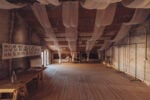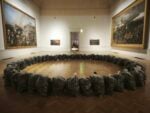AES+F – Mare Mediterraneum
.jpg)
Il Mar Mediterraneo è ancora una volta epicentro di contraddizioni. La guerra vi ha spinto rifugiati e migranti, che, prima di salvarsi, hanno fluttuato e nuotato per affrontare l’Europa, compiendo una scelta difficile. Questa loro scelta ha già portato a scontri politici e ideologici, alla polarizzazione dell’opinione pubblica e all’aumento della xenofobia e della violenza etnica.
Comunicato stampa
MARE MEDITERRANEUM
"Il Mar Mediterraneo è culla di antiche civiltà: da costa a costa, il suo cuore ha “pompato come sangue” persone, culture e religioni. Fenici e Cartaginesi confluirono verso Nord, i Romani e i Crociati si diressero a Sud, i Genovesi a Est, i Bizantini a Ovest, i Califfati islamici si mossero da Est, a Ovest, da Nord a Sud. La Sicilia si trova proprio al crocevia di queste traiettorie, e le diaspore di tutte le civiltà hanno lambito le coste di quest’isola. Proprio come continua ad accadere anche oggi.
Il Mar Mediterraneo è ancora una volta epicentro di contraddizioni. La guerra vi ha spinto rifugiati e migranti, che, prima di salvarsi, hanno fluttuato e nuotato per affrontare l'Europa, compiendo una scelta difficile. Questa loro scelta ha già portato a scontri politici e ideologici, alla polarizzazione dell'opinione pubblica e all'aumento della xenofobia e della violenza etnica.
Una situazione tragica è diventata humus per altri conflitti politici, nonché oggetto di negoziazioni e speculazioni. In questo modo è stata raccontata dai media come caricatura, nel solco di quella che oggi è definita "post-verità". E la deriva etica che l’ha circondata è paradossale, per non dire altro.
Produrre delle statuine di porcellana su questo argomento potrebbe sembrare una manifestazione estrema di questo paradosso. Tuttavia, proprio grazie alla sua distanza, un'immagine artistica può essere più radicale della realtà stessa, perché può spingersi oltre.
La porcellana è sempre stata un simbolo di agio e comodità borghese. Le recenti ondate migratorie hanno messo l'Europa di fronte a un dilemma cruciale: accettare i rifugiati, permettendo loro di entrare a scapito del comfort materiale e psicologico dei loro ospiti; o rifiutarli, con un atto immorale, inumano e cinico, che minerebbe il fondamento etico e cooperativo dell'Europa stessa.
Il comfort è sia fallibile che fragile, proprio come la porcellana. Conservate per generazioni in luoghi “alti”, lontane da possibili pericoli, le statuette di porcellana vengono sorvegliate attentamente, ma la loro fragilità ingloba la minaccia di perdita istantanea. Si frantumano in un attimo.
La forma e il materiale scelti per queste opere sono in contrasto con il dramma di ciò che si sta svolgendo nel Mediterraneo oggi, e così facendo lo sottolineano. Un raggio di luce riflesso illumina meglio di un raggio diretto. Pensiamo che ciò sia vero soprattutto per questo lavoro."
AES+F
MARE MEDITERRANEUM
"The Mediterranean Sea is the reservoir of civilization – its heart has pumped people, cultures, and religions from shore to shore like blood. The Phoenicians and Carthaginians flowed north, the Romans and Crusaders south, the Genoese east, Byzantines west, the Islamic Caliphates east, west, north, and south. Sicily is right in the middle and the waves of all civilizations have splashed on her shores. This is still happening today.
The Mediterranean Sea is once again the epicenter of ideological contradiction. War has pushed refugees and migrants who, saving themselves, have floated and swum across it to confront Europe with a difficult choice. Their choice has already led to politically charged and ideological confrontations, to the polarization of public opinion and to the rise of xenophobia and ethnic violence.
This tragic situation has become a political conflict as well as the subject of negotiation and ideological speculation. In this form it has been transmitted by media as a meme in what is now described as ‘post-truth’. The ethical situation that has unfolded out of this is paradoxical to say the least.
Making porcelain figurines on this subject could be thought an extreme manifestation of this paradox yet, through its distance, an artistic image may be more radical than reality itself because it can push conceptual limits.
Porcelain has always been a symbol of contentment and bourgeois comfort. The recent waves of migrations have confronted Europe with a dilemma: whether to accept refugees – allowing them to enter at the cost of the material and psychological comfort of their hosts; or to reject them in an immoral, inhumane, and cynical act that would undermine the co-operative ethical basis of Europe itself.
Comfort is both fallible and fragile, like the porcelain that is associated with it. Kept safe for generations in high places, porcelain figurines are attentively guarded but their fragility encapsulates the threat of instantaneous loss. They shatter easily.
The chosen form and material of these works contrast with the drama of what is unfolding in the Mediterranean today, and, by doing so, point to it. A reflected ray of light illuminates better than a direct one. We think that this holds true concerning this work."
AES+F



